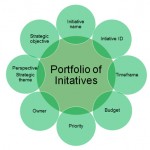Generating value through benefits realization management

For some years now, the massive scale of IT based organizations has become a source of inspiration and best practices in driving growth for almost any other type of company around the world. What is specific for the IT&C operating model is the way of driving strategic value by working in a project based system.
This article is not intended to provide a detailed analysis of the above mentioned industry but rather to use its evolution to better understand the drivers of organizational development and to provide some essential insights on how the rest of us, which are not IT specialists, can manage the value generation process by shaping the business activity using project management tools and methods.
Coming from a performance management dedicated organization, I will express the essence of my endeavour by using KPIs and saying that the present and future organizational value generation paradigm consists in getting from % Projects completed on time and budget to % Project benefits realization and ending with % Projects exceeding Strategic Business Unit (SBU) benefits expectations.
Focusing on projects’ benefits actually means to have the added value in your mind all the way from the initiation phase to the evaluation of a project. Within this context, I also invite you to explore in-depth the Benefits management and identify hands-on approaches to increase the project performance by following a dedicated webinar for which you can register here: KPIs for Project Management.
It all started back in 1998 when John Thorp, from Fujitsu Leadership Centre, advocated in his book, The Information Paradox, the need for managing benefits. In his view, the benefits realization is a continuous process of setting expected results, monitoring progress, doing intermediary evaluations and implementing initiatives on the way so as to lead from investments to business results. However, “benefits rarely happen according to plan” and “do not automatically appear when a project is delivered,” as Thorp admits.
The traditional approach, still present today, is to plan and quantify, as best as possible, the desired results of a project, and to gain the highest accuracy in costs forecasting. But this is not enough for having a strong buy-in on stakeholder’s side. In end the end, everyone wants to know how the life of an organization is improving, besides filling the room with deliverables. Well, starting with a projection of benefits, the perspective over the project enlarges and benefits realization management takes an essential role in project management economy.
Here’s how the benefits realization management transfers into practice.
Starting from the business objectives and the way a proposed project / initiative affects them, a benefits management strategy will be drafted and used to describe “how the project will manage the delivery of the benefits on which the investment decision was made.”
Using control instruments such as Cost-benefit analysis, the project team will be able to argue in favour of the investment decision based on the available data. It’s also true that important benefits are often intangible, therefore difficult to be quantified (Eg: higher work environment quality, higher customer satisfaction). However, the wider the range of benefits identified, the easier to justify the investment. All the benefits are integrated into a plan and monitored constantly as the project goes on and even for a longer period after that. Some benefits can be realized long after the project is finished. Finally, the planned and unplanned benefits will be evaluated against the business objectives.
Within this cycle, key actions are taken, as defined by the Department of Finance and Personnel of UK Government. By identifying and profiling the benefits, the project team will understand the full range of benefits and will be able to involve the right resources and stakeholders in generating them. The early stage identification of benefits and connection with a benefit realization owner will lead to higher engagement at all levels of the project and of the organization.
Knowing what benefits are to be realized, planning them on key project phases and correlating them with milestones, will create the proper context for project success. An essential part of planning is to develop the benefits measurement system through metrics and KPIs. Examples such as: $ Cost avoidance savings or # Earned revenue to total project expenses or $ Project Net Present Value will bring the needed clarity in assessing the project progress and facilitate the calibration initiatives designed to keep things on track and realize the estimated benefits.
Once the project starts, the realization of benefits is “overseen, monitored and controlled with regular reporting to, and input from, established project governance structures.”
Throughout the project implementation process and sometimes years after that, “individual benefits must be tracked, measured, managed and realised by the business.”
Finally, the benefits evaluation is focused on assessing the effectiveness of the project as planned and agreed with stakeholders. Planned costs and benefits are compared with the actual benefits realized and lessons are drawn from the entire project experience.
One last action, but not the least important, is to identify further opportunities to leverage on the actual benefits and multiple them by taking further decisions on new initiatives. You can easily visualize benefits realization management as a ladder. Once one project is finished, you use its benefits to climb another stair which opens new perspectives and offers new benefits to be achieved.
I wish you an endless benefits ladder and a smooth climbing process.
Sources:
- UK Government, Department of Finance and Personnel, 2015
- Thorp, J., The information paradox, 1998, pg.250
- Serra C. E., Kunc, M., Benefits Realisation Management and its influence on project success and on the execution of business strategies (2015) International Journal of Project Management, Vol.33
Source:

Tags: KPI, operational performance, Portfolio and Project Management Performance







